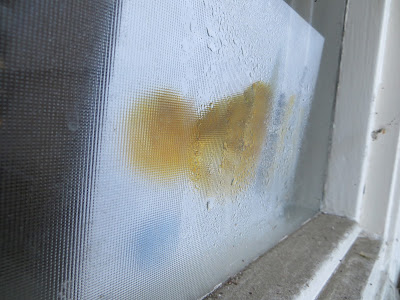Anyone who has heard me speak for more than 10 minutes has
probably heard me talking about dew-point potential. It is at the heart of good building science
principles. Move the dew-point to
somewhere outside of your assemblies, and your assemblies will have a built-in
safety regardless of any air movement through them.
But for many, this dew-point conversation is esoteric and
abstract, they can not usually visualize a dew-point occurring (that they are
aware of, the condensation on the outside of a glass or can of cold liquid is a
demonstration of dew-points) and so cannot appreciate the importance of
reducing its potential in building enclosure construction.
Well by happenstance, I had an excellent example present
itself to me at my home this afternoon.
I was coming back from my neighbour’s house after ‘supervising’ the
dismantling of some scaffolding, when I observed condensation on the inside of
the window near my front door. Now, I
generally have single pane heavy aluminum frame windows throughout my home, so
condensation around the frame margins of the windows is not an unusual occurrence. However this window had a wood frame (site
built) and did not usually suffer from condensation.
Why the difference?
Insulation and air films!
 |
| Condensation spotted on the inside of the window. |
 |
| Inside of window is condensation free except behind some mail propped up against window. |
 |
| Condensation is definitely on the inside face of the window. |
 |
| General window surface temperature 56.5° F |
 | |
| Surface temperature drops to below 51°F behind the mail. |
 | |
| Temperature in nearby region is 68.1°F |
 |
| Temperature behind mail 56.4°F with an RH of 64% |
So, what does this all mean?
I have to admit, that this took a lot longer than it should
have to figure out. On the first round
of measuring, I had RH levels well below 50% and temps of 66.3°F ‘near’ the window
(my office is at 44% and 72°F on the other side of the house and benefiting from
all the heat being pumped out from the computer equipment). At these windows temps
and RH, the dew-point should have been around 47°F which was clearly well below my initial recorded window surface temp of 53°F behind the mail.
So why the condensation?
It then occurred to me that this was a delicate microclimate
and by removing the mail for too long to do the testing and photos, I had inadvertently changed the local
conditions and disturbed the air film that would have been against the surface
of the window. So, I put the mail back
to let the conditions come to equilibrium again and reran the measurements to
get the figures in the photos above. As
you can see, the temperature within a couple of ‘ft’ to the window was now over
68F and the humidity that was building up behind the mail was over 64%. This works out to a dew-point around 56°F and
with a window surface temp of just under 51°F, I was well below the dew-point and had condensation.
The mail was creating enough of a barrier to heat loss (acting as insulation), that it was lowering window surface temperatures over 5F and at the same time was creating
a micro-climate where the humidity was ‘trapped’ by still air and building up
well above the rest of the house.
This demonstration
highlights how delicate the balance can actually be and why heat-bridging in
assemblies is so critical. Whenever you
have isolated conditions that allow a small area of your assembly to cool in
relation to the assembly as a whole, or that allow the build-up of humidity,
you have the recipe for liquid water
formation and when hidden inside an assembly, that can and often does lead to disaster!
No comments:
Post a Comment